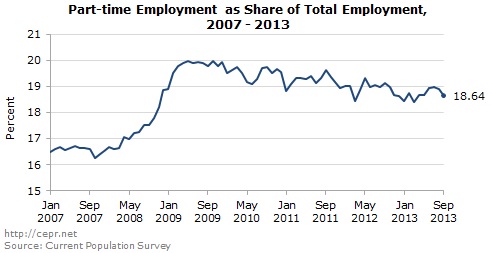October 22, 2013
October 22, 2013 (Jobs Byte)
By Dean Baker
Workers with less than a high school degree saw a drop of 1.0 percentage point in their unemployment rate over the last year.
The unemployment rate edged down to 7.2 percent in September, the lowest level since November of 2008. The Labor Department’s establishment survey showed a gain of 148,000 jobs. With modest upward revisions to the prior two months’ data, this brings the average rate of job growth over the last three months to 143,000. This compares with an average rate of job growth of 186,000 a month over the last year.
In spite of the September drop in unemployment, the employment-to-population rate (EPOP) remained unchanged at 58.6 percent. This continues the pattern that we have seen throughout the recovery as the unemployment rate falls mainly because workers leave the labor market. The unemployment rate is now down by 2.8 percentage points from its 10.0 percent peak in October of 2009. However, the EPOP is up just 0.4 percentage points from its low point in June of 2011. Over the last year the EPOP actually edged down by 0.1 percentage point, while the unemployment rate dropped by 0.6 percentage points. This drop in labor force participation is now occurring at an equal pace among men and women, with the participation of both dropping 0.5 percentage points in the last year.
By educational attainment, workers with less than a high school degree were the big winners in September with a drop of a full percentage point in their unemployment rate to 10.3 percent. That is down from a peak of 15.7 percent in November of 2010. This decline was also accompanied by a drop of 0.3 percentage points in the EPOP over the last month, but over the last year the EPOP for the least-educated workers is down by just 0.1 percentage point. This is also likely due to the aging of the population since older workers disproportionately lack high school degrees. The strong relative gains by workers with the least education does not easily fit with accounts of the economy increasingly demanding higher-skilled workers.
Foreign-born workers also seem to be doing relatively well in the recovery. In the last year their unemployment rate is down by 1.1 percentage point to 6.5 percent, while their EPOP rose by 1.0 percentage points to 61.9 percent. By comparison, the unemployment rate for native-born workers fell by just 0.5 percentage points to 7.1 percent.
Other data in the household survey were mostly positive. The percentage of unemployment due to people voluntary quitting their jobs rose back to 8.8 percent, tying the high for the recovery hit in June. The duration measures were little changed, although the share of the unemployed who were out of work for more than 27 weeks fell 1.0 percentage point to 36.9 percent, the lowest since October of 2009. However, this is probably more attributable to shorter benefit duration than an improvement in job prospects. The number of people working part time continued to fall back, continuing the trend of the last three years.
The establishment data suggest that the modest pace of job growth seen over the last year may be slowing further. On closer inspection, the September data look even worse than the headline number. The job growth reported in several sectors was almost certainly an anomaly.
For example, wholesale trade reportedly added 16,100 jobs, the largest gain since January of 2012. Transit and ground transportation added 17,900 jobs, although this was mostly reversing a 22,100 drop reported for July. And state and local government education added 29,300 jobs in September after adding 43,000 in August. All of these rises are likely flukes that will not be repeated in the months ahead, if not actually reversed.
On the other side, health care created just 6,800 jobs, while restaurants lost 7,100 jobs. This compares with average monthly job growth over the year of 22,000 and 25,000, respectively.
Hours were unchanged in September, while the average hourly wage increased at a 1.8 percent annual rate over the last three months. This is down slightly from a 2.1 percent rate of increase over the last year.
On the whole, this is not a very encouraging report. It reinforces the notion that the economy had slowed in the third quarter. This is before any negative effects of the shutdown.







